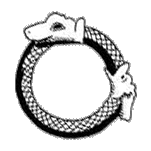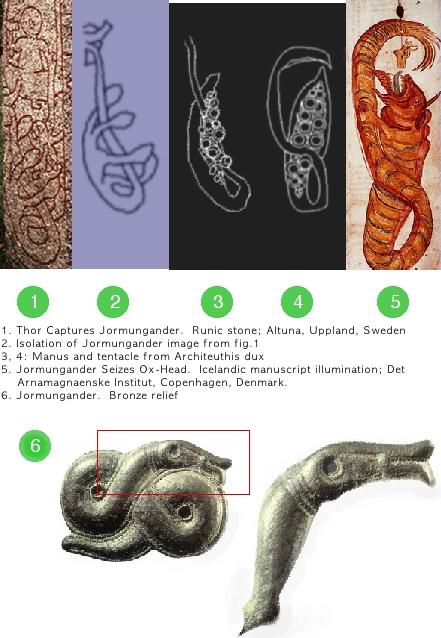|
|
 |
 |
Reply
 | | | Message 7 of 14 in Discussion |
|
Reply
 | | Zaltys or the snake is also related to the World Tree. In this case, zaltys becomes a symbol of the life-force in vegetation and Mother Earth. The theme of woman, serpent and tree are seen in the Lithuanian myth of "Egle, Queen of Serpents", the Bible and other pagan myths. Alchemy and the Snake The serpent has long been associated with the practice of alchemy, an ancient specialization of European and Asian scholars. The objective was to discover a way to transmute base metals into gold, and to find the fabled elixir of immortality. Many contemporary researchers feel that the procedures described in alchemical texts were actually coded references to spiritual practices, rather than a form of elementary chemistry.  The endless serpent is one important image found in these alchemy books. It first appeared on a page in Kleopatra's book of the 10th century CE. In the space bounded by the snake holding its tail in its mouth was inscribed, "One is the All, and by it, the All, and in it, the All, and if it does not contain the All, then it is Nothing." The endless serpent is one important image found in these alchemy books. It first appeared on a page in Kleopatra's book of the 10th century CE. In the space bounded by the snake holding its tail in its mouth was inscribed, "One is the All, and by it, the All, and in it, the All, and if it does not contain the All, then it is Nothing."
This image, called the Ourobouros, appears also in the Codex Marciannus [Mark's reference is to alchemical procedures such as distillation, condensation, 'sublimation' and transformation. Kekule [1829-1896], the German chemist, had a lucid dream about Ourobouros (while on a bus, it is said!) that has often been referred to as the most "brilliant piece of prediction" in all organic chemistry. It revealed to him the long-sought carbon ring structure of the benzene molecule. The endless serpent signifies that all matter is basically interchangeable, and that forms are not absolute. In fact, we have in the Ourobouros the symbol for what is known in Buddhist philosophy as shunyata [Sanskrit] or Emptiness. The Codex explains that Ourobouros: - in its ensemble it is devoured, melted, dissolved and transformed by the process of putrefaction [decay]. It becomes a deep green, and the colour gold is derived from it. [Then] is derived the red called the colours of cinnabar.
- ... its head is deep green. Its four feet are the tetrasomei [4 base metals: copper, iron, lead and tin.] Its 3 ears are the sublime vapours: sulphur, mercury, orpiment.
- The One furnishes the Other in blood; the One gives birth to the Other. Nature rejoices in nature; nature triumphs over Nature ... .
- ... my dear friend, apply thy intelligence to these matters, and thou wilt not fall into error; but work seriously and without negligence, until thou hast seen the end of the Process ... .
- A serpent is stretched, guarding this temple, and he who has subdued it commences by sacrificing it, then roasts it, and after removing its flesh from its bones, make of it a step to the entrance of the temple. Mount upon it and thou shalt find the object sought. For the priest becomes at first a man of silver, a few days later, thou wilt find him changed into a man of gold.
The student of tantric yoga will surely recognize these references ~ alchemy is not solely about transforming what is outside us. | | Reply
 | | Dangers & Drawbacks of Tantric Practice if unprepared -
Without Refuge in the Three Gems you are "on your own." -
Without a guru it is as if you are walking in the dark -
Without the empowerment or initiation is as if you have no map -
Without devotion or faith, there cannot be whole-hearted commitment to the task -
Without purification, neurotic tendencies such as feelings of unworthiness or pride, and so on, stand in the way of accomplishment. -
Without generosity, you might think it is possible to accrue personal merit. -
Without awareness of Emptiness, you could easily end up falling into superstition, worshiping idols, and ending up in a far worse position than before. | | Reply
 | | Réponse
 | | </NOINDEX> seraph , plural seraphim<NOINDEX> [–im] </NOINDEX>, supernatural being. The name seems to derive from the Hebrew word “to burn.�?According to the Book of Isaiah, seraphim have six wings. Scholars have suggested that seraphim were winged serpents. In Numbers, the word “seraph�?denotes a “fiery�?(i.e. poisonous) serpent. Like cherubim, seraphim are associated with the glory of God, as in the liturgy. See also cherub. | | Réponse
 | | </NOINDEX> Apis , in Egyptian religion, sacred bull of Memphis, said to be the incarnation of Osiris or of Ptah. His worship spread throughout the Mediterranean world and was particularly important during the time of the Roman Empire. See also Serapis. Serapis or Sarapis<NOINDEX> [särä'pis] </NOINDEX>, Egyptian god whose devotees united the worship of the Apis bull and the god Osiris. His cult, which originated at Memphis, rose to its greatest significance at Alexandria during the reign of Ptolemy I. He was adopted as the universal godhead by some Gnostic sects. In Greece during Hellenistic times and later during the Roman Empire his worship rivaled that of other Middle Eastern and Mediterranean cults. | | | | Reply
 | | MIDGARD SERPENT The great snake which lies in the ocean and encircles the world, its tail in its mouth. On the day of Ragnarok, the world will disappear under the ocean's waters when the Midgard Serpent rises from the sea. Thor will kill the Midgard Serpent but will be killed by the Serpent's poison. In "The Prose Edda" of Snori Sturlason, a compendium of Norse pagan myths written in 1220 A.D., Thor, the Norse god of thunder, twice encounters a creature known as Jormungander, the "World Serpent," also known as the Midgard Serpent. Jormungander was said to be one of three offspring of the trickster-god Loki and the giantess Angrboda, and so prodigious was the size of their monstrous, aquatic child that it coiled about the entirety of the world. Thor first encounters Jormungander in the company of the giant Hymir, whom Thor press-gangs into service as a rower in an attempt to capture Jormungander. Taking the severed head of Hymir's favorite ox Himinbrjotr, "Sky Bellower," as bait for the serpent, Thor and the giant row out into the sea. Thor ties a long line to a hook he has fashioned, impales the ox-head with it and lowers the bait to the bottom of the sea. The narrative continues, per Sturlason: "The Midgard Serpent snapped at the ox-head, and the hook caught in its jaw; but when the Serpent was aware of this, it dashed away so fiercely that both Thor's fists crashed against the gunwale. Then Thor was angered, and took upon him his divine strength, braced his feet so strongly that he plunged through the ship with both feet, and dashed his feet against the bottom; then he drew the Serpent up to the gunwale. And it may be said that no one has seen very fearful sights who might not see that: how Thor flashed fiery glances at the Serpent, and the Serpent in turn stared up toward him from below and blew venom." (Sturlason, The Prose Edda, Brodeur translation) Then, just as Thor is about to dispatch the beast with his hammer, Hymir, scared out of his wits (and probably more than a little resentful about the loss of his ox) severs the line, whereupon the serpent disappears below the waves. Thor's second, final encounter with Jormungander comes at the time of Ragnarok, the incineration of the world that prefigures the rebirth of man; Thor and Jormungander fight to the death, Jormungander by hammer-blow and Thor by the venomous secretions of the serpent.  Visual representations of the Midgard serpent typically present a long, sinuous creature that coils upon itself, sometimes as a hooped serpent with it's tail in it's mouth, and at others as a kind of living Mobius strip. One of the more famous images appears on a carved granite obelisk in Altuna, Sweden. Colored with iron oxide-pigment, the Runic carving depicts Thor hauling a writhing Jormungander to the surface (Fig.1). Within a nest of heads on slender necks, the beast grasps the tethered head of Sky-Bellower. An isolation of the Jormungander element (Fig. 2) gives us an idea of the thing's general planform. | | |
|
|
|
 Free Forum Hosting
Free Forum Hosting